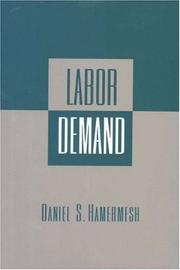| Listing 1 - 3 of 3 |
Sort by
|
Book
Year: 1993 Publisher: Cambridge, Mass. National Bureau of Economic Research
Abstract | Keywords | Export | Availability | Bookmark
 Loading...
Loading...Choose an application
- Reference Manager
- EndNote
- RefWorks (Direct export to RefWorks)
Laws in most Western European countries give workers strong job rights, including the right to advance notice of layoff and the right to severance pay or other compensation if laid off. Many of these same countries also encourage hours adjustment in lieu of layoffs by providing prorated unemployment compensation to workers on reduced hours. This paper compares the adjustment of manufacturing employment and hours in West Germany, France and Belgium, three countries with strong job security regulations and well-established short-time compensation systems, with that in the United States. Although the adjustment of employment to changes in output is much slower in the German, French and Belgian manufacturing sectors than in U.S. manufacturing, the adjustment of total hours worked is much more similar. The short-time system makes a significant contribution to observed adjustment in all three European countries. In addition, we find little evidence that the weakening of job security regulations that occurred in Germany, France and Belgium during the 1980s affected employers' adjustment to changes in output. These findings suggest that. given appropriate supporting institutions. strong job security need not inhibit employer adjustment to changing conditions.
Job security --- Law and legislation. --- Law and legislation

ISBN: 0875461883 Year: 1993 Publisher: Ithaca, N.Y. ILR Press
Abstract | Keywords | Export | Availability | Bookmark
 Loading...
Loading...Choose an application
- Reference Manager
- EndNote
- RefWorks (Direct export to RefWorks)
Job security --- Labor market --- 331.52 --- 331.5 --- 331.52 Arbeidsmarktstructuur. Vraag en aanbod op de arbeidsmarkt. Spreiding van arbeidsplaatsen. Spreiden van arbeidskrachten. Tewerkstellingsgraad --- Arbeidsmarktstructuur. Vraag en aanbod op de arbeidsmarkt. Spreiding van arbeidsplaatsen. Spreiden van arbeidskrachten. Tewerkstellingsgraad --- Employees --- Market, Labor --- Supply and demand for labor --- Markets --- 331.5 Arbeidsmarkt. Werkgelegenheid --(algemeen) --- Arbeidsmarkt. Werkgelegenheid --(algemeen) --- Employment protection --- Employment security --- Job insecurity --- Security, Job --- Economic security --- Personnel management --- Layoff systems --- Supply and demand --- Labour market --- Organisation for Economic Co-operation and Development

ISBN: 0691025878 0691042543 0691222991 9780691042541 Year: 1993 Publisher: Princeton (N.J.): Princeton university press,
Abstract | Keywords | Export | Availability | Bookmark
 Loading...
Loading...Choose an application
- Reference Manager
- EndNote
- RefWorks (Direct export to RefWorks)
In this book Daniel Hamermesh provides the first comprehensive picture of the disparate field of labor demand. The author reviews both the static and dynamic theories of labor demand, and provides evaluative summaries of the available empirical research in these two subject areas. Moreover, he uses both theory and evidence to establish a generalized framework for analyzing the impact of policies such as minimum wages, payroll taxes, job- security measures, unemployment insurance, and others. Covering every aspect of labor demand, this book uses material from a wide range of countries.
331.52 --- Labor demand --- Labor market --- Employees --- Market, Labor --- Supply and demand for labor --- Markets --- Demand, Labor --- Demand for labor --- 331.52 Arbeidsmarktstructuur. Vraag en aanbod op de arbeidsmarkt. Spreiding van arbeidsplaatsen. Spreiden van arbeidskrachten. Tewerkstellingsgraad --- Arbeidsmarktstructuur. Vraag en aanbod op de arbeidsmarkt. Spreiding van arbeidsplaatsen. Spreiden van arbeidskrachten. Tewerkstellingsgraad --- Supply and demand --- Labor demand. --- 331.526 --- 331.123 --- Levels of employment. Employment situation, conditions --- #A9402E --- 331.526 Levels of employment. Employment situation, conditions --- 332.630 --- 332.691 --- AA / International- internationaal --- Strijd tegen de werkloosheid: algemeen. Theorie en beleid van de werkgelegenheid. Volledige werkgelegenheid --- Evolutie van de arbeidsmarkt --- Labour market --- Labor market. --- Marché du travail --- Mercado de trabajo. --- Cobb–Douglas production function. --- Comparative advantage. --- Compensating differential. --- Contract curve. --- Cost curve. --- Demand For Labor. --- Demand response. --- Derived demand. --- Developed country. --- Developing country. --- Earnings. --- Economic cost. --- Economic efficiency. --- Economic forces. --- Economic interventionism. --- Economics. --- Efficiency wage. --- Efficiency. --- Elasticity of intertemporal substitution. --- Elasticity of substitution. --- Employment. --- Endogenous growth theory. --- Estimation. --- Excess supply. --- Externality. --- Factor cost. --- Factor price. --- Implicit cost. --- Income elasticity of demand. --- Indifference curve. --- Induced innovation. --- Inelastic. --- Inflation. --- Instrumental variable. --- Investment goods. --- Isoquant. --- Job security. --- John Haltiwanger. --- Labour supply. --- Law of demand. --- Layoff. --- Living wage. --- Long run and short run. --- Mandatory retirement. --- Manufacturing in the United States. --- Marginal cost. --- Marginal product. --- Marginal rate of substitution. --- Marginal rate of technical substitution. --- Maximum wage. --- Minimum wage. --- Monopsony. --- Neoclassical economics. --- Net Change. --- Net investment. --- New Keynesian economics. --- Oligopoly. --- Outsourcing. --- Partial equilibrium. --- Payroll tax. --- Phillips curve. --- Present value. --- Price Change. --- Price elasticity of demand. --- Price elasticity of supply. --- Production function. --- Productive efficiency. --- Productivity. --- Profit (economics). --- Profit maximization. --- Real business-cycle theory. --- Real versus nominal value (economics). --- Real wages. --- Recession. --- Reservation wage. --- Response Lag. --- Risk aversion. --- Scarcity. --- Shephard's lemma. --- Shortage. --- Stephen Nickell. --- Subsidy. --- Substitution effect. --- Supply (economics). --- Supply and demand. --- Supply shock. --- Tax incidence. --- Tax. --- Theory of the firm. --- Time preference. --- Total cost. --- Total factor productivity. --- Trade barrier. --- Unemployment in the United States. --- Unemployment. --- Utility. --- Utilization. --- Variable cost. --- Wage.
| Listing 1 - 3 of 3 |
Sort by
|

 Search
Search Feedback
Feedback About UniCat
About UniCat  Help
Help News
News